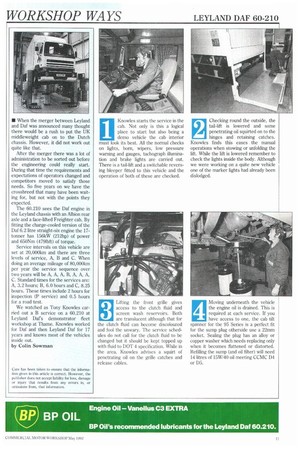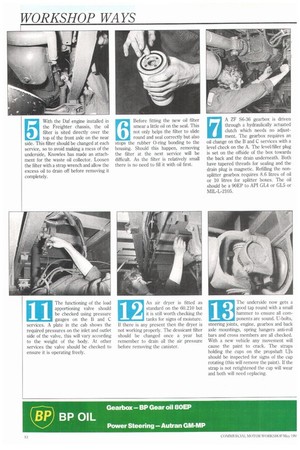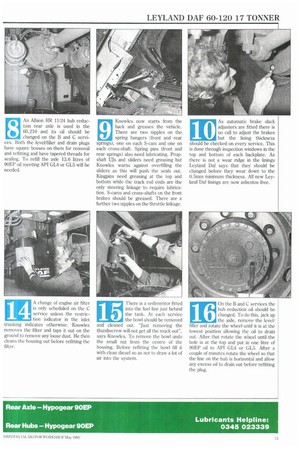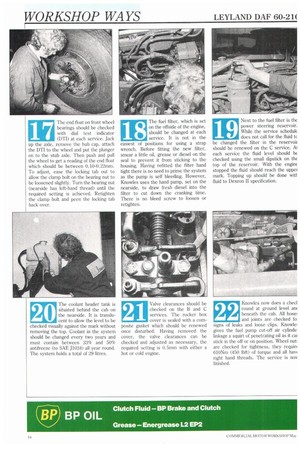• When the merger between Leyland and Daf was announced
Page 103

Page 104

Page 105

Page 106

If you've noticed an error in this article please click here to report it so we can fix it.
many thought there would be a rush to put the UK middleweight cab on to the Dutch chassis. However, it did not work out quite like that.
After the merger there was a lot of administration to be sorted out before the engineering could really start. During that time the requirements and expectations of operators changed and competitors moved to satisfy those needs. So five years on we have the crossbreed that many have been waiting for, but not with the points they expected.
The 60.210 sees the Daf engine in the Leyland chassis with an Albion rear axle and a face-lifted Freighter cab. By fitting the charge-cooled version of the Daf 6.2 litre straight-six engine the 17tonner has 156kW (212hp) of power and 650Nm (4791bft) of torque.
Service intervals on this vehicle are set at 20,000km and there are three levels of service, A, B and C. When doing an average mileage of 80,000kra per year the service sequence over two years will be A, A, A, B, A, A, A, C. Standard times for the services are A, 3.2 hours; B, 6.0 hours and C, 8.25 hours. These times include 2 hours for inspection (P service) and 0.5 hours for a road test.
We watched as Tony Knowles carried out a B service on a 60.210 at Leyland Daf's demonstrator fleet workshop at Thame. Knowles worked for Daf and then Leyland Daf for 17 years and knows most of the vehicles inside out.
by Colin Sowman Knowles starts the service in the cab. Not only is this a logical place to start but also being a demo vehicle the cab interior must look its best. All the normal checks on lights, horn, wipers, low pressure warning and gauges, tachograph illumination and brake lights are carried out. There is a tail-lift and a switchable reversing bleeper fitted to this vehicle and the operation of both of these are checked. NChecking round the outside, the tail-lift is lowered and some penetrating oil squirted on to the hinges and retaining catches. Knowles finds this eases the manual operations when stowing or unfolding the lift. While the lift is lowered remember to check the lights inside the body. Although we were working on a quite new vehicle one of the marker lights had already been dislodged.
3 Lifting the front grille gives
access to the clutch fluid and screen wash reservoirs. Both are translucent although that for the clutch fluid can become discoloured and fool the unwary. The service schedules do not call for the clutch fluid to be changed but it should be kept topped up with fluid to DOT 4 specification. While in the area, Knowles advises a squirt of penetrating oil on the grille catches and release cables.
4 Moving underneath the vehicle
the engine oil is drained. This is required at each service. If you have access to one, the cab tilt spanner for the 95 Series is a perfect fit for the sump plug otherside use a 22mm socket. Sealing the plug has an alloy or copper washer which needs replacing only when it becomes flattened or distorted. Refilling the sump (and oil filter) will need 14 litres of 15W/40 oil meeting CCMC D4 or D5. With the Daf engine installed in the Freighter chassis, the oil filter is sited directly over the top of the front axle on the near side. This filter should be changed at each service, so to avoid making a mess of the underside, Knowles has made an attachment for the waste oil collector. Loosen the filter with a strap wrench and allow the excess oil to drain off before removing it completely. Before fitting the new oil filter smear a little oil on the seal. This not only helps the filter to slide round and seal correctly but also stops the rubber 0-ring bonding to the housing. Should this happen, removing the filter at the next service will be difficult. As the filter is relatively small there is no need to fill it with oil first. A ZF S6-36 gearbox is driven through a hydraulically actuated clutch which needs no adjustment. The gearbox requires an oil change on the B and C services with a level check on the A. The level/filler plug is set on the offside of the box towards the back and the drain underneath. Both have tapered threads for sealing and the drain plug is magnetic. Refilling the nonsplitter gearbox requires 8.6 litres of oil or 10 litres for splitter boxes. The oil should be a 90EP to API GL4 or GL5 or MIL-L-2105. An Albion HR 11/24 hub reduction rear axle is used in the 60.210 and its oil should be changed on the B and C services. Both the level/filler and drain plugs have square bosses on them for removal and refitting and have tapered threads for sealing. To refill the axle 13.6 litres of 90E1' oil meeting API GL4 or GL5 will be needed. Knowles now starts from the back and greases the vehicle. There are two nipples on the spring hangers (front and rear springs), one on each S-cam and one on each cross-shaft. Spring pins (front and rear springs) also need lubricating. Propshaft Ws and sliders need greasing but Knowles warns against overfilling the sliders as this will push the seals out. Kingpins need greasing at the top and bottom while the track rod ends are the only steering linkage to require lubrication. S-cams and cross-shafts on the front brakes should be greased. There are a further two nipples on the throttle linkage.
10 As automatic brake slack adjusters are fitted there is
no call to adjust the brakes but the lining thickness should be checked on every service. This is done through inspection windows in the top and bottom of each backplate. As there is not a wear ridge in the linings Leyland Daf says that they should be changed before they wear down to the 0.5mm minimum thickness. All new Leyland Daf linings are now asbestos free.
The functioning of the load apportioning valve should be checked using pressure gauges on the B and C services. A plate in the cab shows the required pressures on the inlet and outlet side of the valve, this will vary according to the weight of the body. At other services the valve should be checked to ensure it is operating freely.
11 12 An air dryer is fitted as
standard on the 60.210 but it is still worth checking the tanks for signs of moisture. If there is any present then the dryer is not working properly. The dessicant filter should be changed once a year but remember to drain all the air pressure before removing the canister.
13 The underside now gets a
good tap round with a small hammer to ensure all com ponents are sound. U-bolts, steering joints, engine, gearbox and back axle mountings, spring hangers anti-roll bars and cross members are all checked. With a new vehicle any movement will cause the paint to crack. The straps holding the cups on the propshaft UJs should be inspected for signs of the cup rotating (this will remove the paint). If the strap is not retightened the cup will wear and both will need replacing.
14 A change of engine air filter is only scheduled on the C
service unless the restric tion indicator in the inlet trunking indicates otherwise. Knowles removes the filter and taps it out on the ground to remove any loose dust. He then cleans the housing out before refitting the filter.
15 There is a sedimentor fitted into the fuel line just behind
the tank. At each service the bowl should be removed and cleaned out. "Just removing the thumbscrew will not get all the muck out", says Knowles. To remove the bowl undo the small nut from the centre of the housing. Before refitting the bowl fill it with clean diesel so as not to draw a lot of air into the system.
16 On the B and C services the
hub reduction oil should be changed. To do this, jack up the axle, remove the level/ filler and rotate the wheel until it is at the lowest position allowing the oil to drain out. After that rotate the wheel until the hole is at the top and put in one litre of 90EP oil to API GL4 or GL5. After a couple of minutes rotate the wheel so that the line on the hub is horizontal and allow any excess oil to drain out before refitting the plug. The end float on front wheel bearings should be checked with dial test indicator (DTI) at each service. Jack up the axle, remove the hub cap, attach the DTI to the wheel and put the plunger on to the stub axle. Then push and pull the wheel to get a reading of the end float which should be between 0.10-0.22nun. To adjust, ease the locking tab out to allow the clamp bolt on the bearing nut to be loosened slightly. Turn the bearing nut (nearside has left-hand thread) until the required setting is achieved. Retighten the clamp bolt and peen the locking tab back over.
17 18 The fuel filter, which is set
on the offside of the engine, should be changed at each service. It is not in the easiest of positions for using a strap wrench. Before fitting the new filter, smear a little oil, grease or diesel on the seal to prevent it from sticking to the housing. Having refitted the filter hand tight there is no need to prime the system as the pump is self bleeding. However, Knowles uses the hand pump, set on the nearside, to draw fresh diesel into the filter to cut down the cranking time. There is no bleed screw to loosen or retighten.
19 Next to the fuel filter is th. power steering reservoir.
While the service scheduk
does not call for the fluid tc be changed the filter in the reservoii should be renewed on the C service. At each service the fluid level should lx checked using the small dipstick on tlx top of the reservoir. With the engin( stopped the fluid should reach the uppei mark. Topping up should be done wit'. fluid to Dexron 11 specification.
20 The coolant header tank is situated behind the cab on
the nearside. It is translu cent to allow the level to be checked visually against the mark without removing the top. Coolant in the system should be changed every two years and must contain between 33% and 50% antifreeze (to SAE J1034) all year round. The system holds a total of 29 litres.
21 Valve clearances should be checked on the B and C
services. The rocker box cover is sealed with a composite gasket which should be renewed once disturbed. Having removed the cover, the valve clearances can be checked and adjusted as necessary, the required setting is 0.5mm with either a hot or cold engine.
22 Knowles now does a checl round at ground level an(
beneath the cab. All hose and joints are checked fo signs of leaks and loose clips. Knowle gives the fuel pump cut-off air cylinde linkage a squirt of penetrating oil as it cal stick in the off or on position. Wheel nut: are checked for tightness, they requin 610Nm (450 lbft) of torque and all hay( right hand threads. The service is nov finished.




















































































































